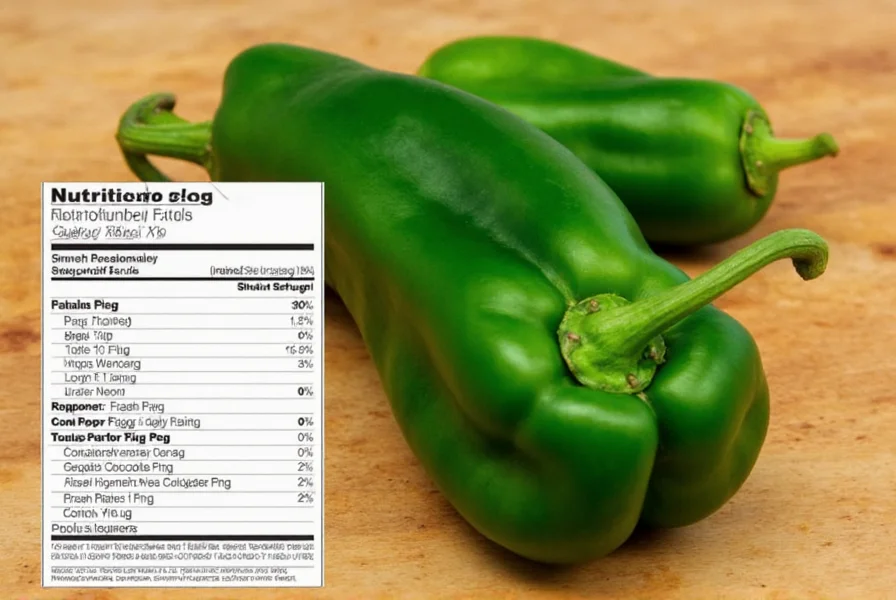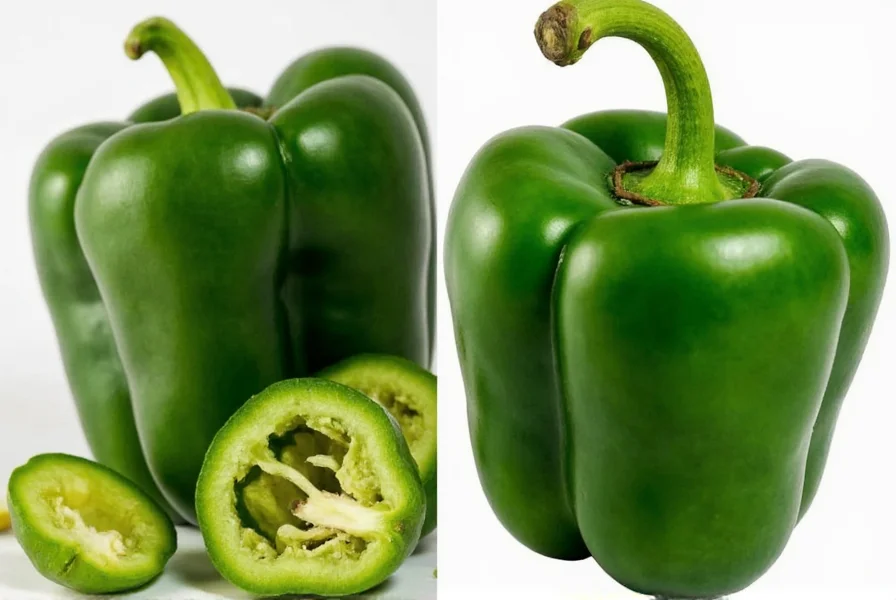One medium poblano pepper (98g) contains 22 calories, 3g fiber, and delivers 125% of your daily vitamin C needs. Rich in vitamins A, B6, and K, plus potassium and antioxidants, poblano peppers offer significant nutritional benefits with minimal heat.
Often overshadowed by their spicier chili pepper cousins, poblano peppers provide exceptional nutritional value with a mild, earthy flavor. These large, heart-shaped peppers native to Mexico are a staple in Southwestern and Mexican cuisine, commonly used in dishes like chiles rellenos and mole poblano. Understanding poblano pepper nutrition facts helps health-conscious eaters incorporate this versatile vegetable into balanced diets.

Nutritional Profile of Poblano Peppers
Per 100 grams of raw poblano pepper, the nutritional composition includes:
| Nutrient | Amount | % Daily Value* |
|---|---|---|
| Calories | 20 kcal | 1% |
| Total Fat | 0.2g | 0% |
| Carbohydrates | 4.4g | 2% |
| Dietary Fiber | 2.7g | 10% |
| Sugars | 2.2g | - |
| Protein | 1.2g | 2% |
| Vitamin C | 143.7mg | 159% |
| Vitamin A | 1533 IU | 31% |
| Vitamin B6 | 0.3mg | 15% |
| Vitamin K | 22.3mcg | 19% |
| Potassium | 223mg | 6% |
| Copper | 0.1mg | 11% |
*Percent Daily Values are based on a 2,000 calorie diet. Your daily values may be higher or lower depending on your calorie needs.
Health Benefits of Poblano Pepper Nutrition
The impressive nutritional profile of poblano peppers translates to several health advantages. Their exceptionally high vitamin C content supports immune function and collagen production while acting as a powerful antioxidant. Unlike many vitamin C sources, poblano peppers maintain their nutritional value even when cooked, making them versatile for various preparation methods.
One poblano pepper nutrition fact that often surprises people is its substantial vitamin A content, primarily from beta-carotene. This nutrient supports eye health and skin integrity. The combination of vitamins A and C creates a synergistic antioxidant effect that helps combat oxidative stress in the body.
When examining poblano pepper calories and macros, you'll notice they're extremely low in calories while providing meaningful fiber content. This makes them an excellent addition to weight management diets. The dietary fiber in poblano peppers supports digestive health and helps maintain stable blood sugar levels.

Comparing Poblano Pepper Nutrition to Other Varieties
How does poblano pepper nutrition compare to other common peppers? The table below shows key differences:
| Pepper Type | Scoville Units | Vitamin C (per 100g) | Calories (per 100g) | Notable Nutrients |
|---|---|---|---|---|
| Poblano | 1,000-2,000 | 143.7mg | 20 | Vitamins A, B6, K, potassium |
| Bell Pepper | 0 | 128mg | 20 | Vitamins A, E, folate |
| Jalapeño | 2,500-8,000 | 118mg | 29 | Vitamin B3, capsaicin |
| Habanero | 100,000-350,000 | 112mg | 45 | Vitamin A, capsaicin |
Poblano peppers offer a unique nutritional advantage with their moderate heat level combined with high vitamin content. Unlike bell peppers which have zero heat, poblanos provide capsaicin—the compound responsible for chili heat—which has been linked to metabolic benefits and pain relief. However, they're significantly milder than jalapeños, making them accessible to more palates while still delivering nutritional benefits associated with capsaicin.
Maximizing Nutritional Value in Preparation
Understanding how to prepare poblano peppers affects their nutritional profile. Roasting poblano peppers actually increases their antioxidant availability, particularly carotenoids. The mild heat of poblano peppers means they can be consumed in larger quantities than hotter varieties, allowing for greater nutrient intake.
When considering poblano pepper nutrition facts for cooking, remember that vitamin C is water-soluble and can leach into cooking liquids. To preserve maximum nutrients, avoid boiling and opt for roasting, grilling, or stir-frying. The skin of poblano peppers contains concentrated nutrients, so leaving it on during preparation maximizes nutritional benefits.
For those tracking poblano pepper calories for weight loss, these peppers make an excellent low-calorie, high-volume food. Stuffing poblano peppers with lean proteins and vegetables creates a nutritionally balanced meal that's both satisfying and nutrient-dense.
Practical Uses in Healthy Eating
Incorporating poblano peppers into your diet offers versatile options for enhancing nutritional intake. Their mild flavor profile makes them suitable for various dietary preferences and restrictions. For those following poblano pepper nutrition for weight loss, consider these preparation methods:
- Stuffed poblanos with quinoa, black beans, and lean turkey
- Blended into smooth salsas with tomatoes and cilantro
- Sliced into omelets or frittatas for added nutrients
- Roasted and added to soups and stews for depth of flavor
- Chopped into salads for a mild, flavorful crunch
The poblano pepper nutrition chart reveals why these peppers deserve more attention in healthy meal planning. Their combination of low calories, high fiber, and exceptional vitamin content makes them a nutritional powerhouse that's accessible to most palates.
Frequently Asked Questions
How many calories in a poblano pepper?
A medium poblano pepper (approximately 98g) contains about 22 calories. This makes poblano peppers an excellent low-calorie addition to meals for those monitoring their calorie intake while seeking nutrient-dense foods.
Are poblano peppers high in vitamin C?
Yes, poblano peppers are exceptionally high in vitamin C. One medium poblano pepper provides approximately 125% of the recommended daily value of vitamin C, making them an excellent source of this essential nutrient that supports immune function and skin health.
How does poblano pepper nutrition compare to bell peppers?
Poblano peppers contain slightly more vitamin C than bell peppers (143.7mg vs 128mg per 100g) while having similar calorie content. The key difference is that poblanos contain capsaicin, providing mild heat and associated metabolic benefits, while bell peppers have zero heat. Both are excellent sources of vitamins A and C.
Can you eat poblano pepper seeds?
Yes, poblano pepper seeds are edible and contain concentrated nutrients, including fiber and antioxidants. While some people prefer to remove them for texture reasons, they're perfectly safe to eat and contribute to the overall nutritional value of poblano peppers. The seeds contain most of the capsaicin, so removing them reduces heat.
Do poblano peppers have health benefits for digestion?
Yes, poblano peppers support digestive health through their fiber content (approximately 3g per medium pepper) and capsaicin. The dietary fiber promotes regular bowel movements and feeds beneficial gut bacteria, while capsaicin may stimulate digestive enzyme production. This makes poblano pepper nutrition beneficial for maintaining a healthy digestive system.











 浙公网安备
33010002000092号
浙公网安备
33010002000092号 浙B2-20120091-4
浙B2-20120091-4